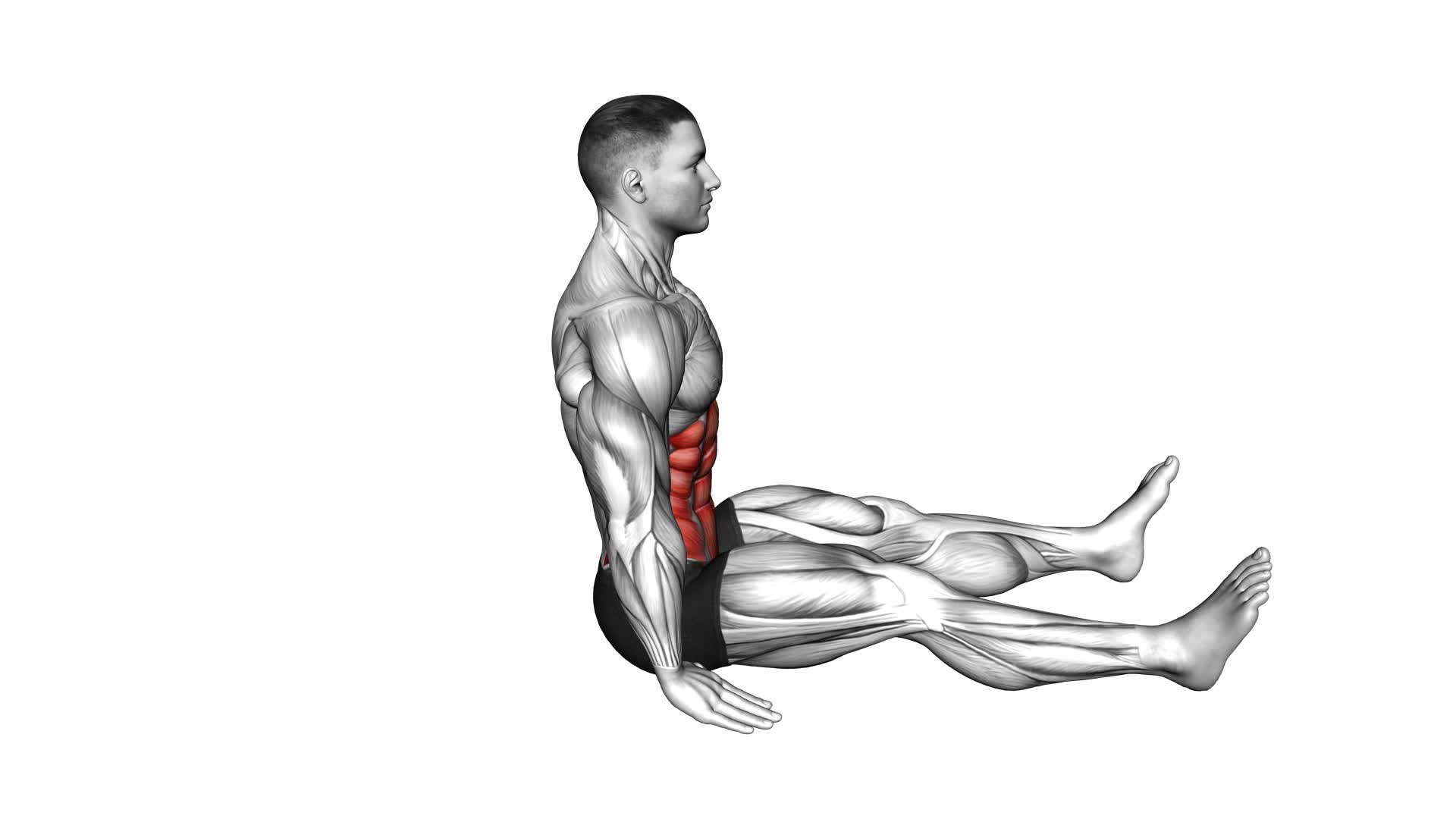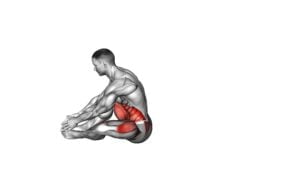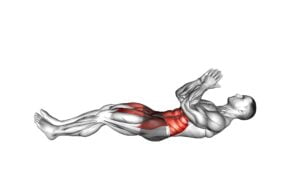Half Sit-up (male) – Video Exercise Guide & Tips

Looking to strengthen your core? Check out this video exercise guide and tips for half sit-ups specifically designed for men.
Watch This Exercise Video
Learn the proper form and technique to get the most out of this exercise while avoiding common mistakes.
Beginners can also find modifications to gradually build strength, while advanced variations are available for those looking for an extra challenge.
Maximize the effectiveness of your half sit-ups with these expert tips.
Let's get started!
Key Takeaways
- Half sit-ups strengthen core muscles and target rectus abdominis, obliques, and transverse abdominis.
- Half sit-ups can help achieve a defined and sculpted midsection and improve overall athletic performance.
- Proper form and technique, such as engaging core muscles, maintaining proper alignment, and avoiding common mistakes, are crucial for maximizing the benefits of half sit-ups.
- Modifications, progressions, and alternative variations can be used to challenge core muscles, improve strength, and increase the intensity of half sit-ups.
Benefits of Half Sit-ups for Men
Improve your core strength and abdominal muscles with half sit-ups, a beneficial exercise for men. Half sit-ups, also known as crunches, target the rectus abdominis, obliques, and transverse abdominis muscles. These exercises are specifically designed to strengthen and tone your abs, helping you achieve a more defined and sculpted midsection.
One of the main benefits of half sit-ups for men is the development of strong core muscles. Your core is responsible for stabilizing your body and supporting your spine during movements. By regularly performing half sit-ups, you can enhance your core strength, which can improve your overall athletic performance and decrease the risk of lower back pain.
Another advantage of half sit-ups is that they can help you achieve a six-pack or toned abs. By engaging your abdominal muscles with each repetition, half sit-ups contribute to the development of a firmer and more defined midsection. These exercises are particularly effective for targeting the rectus abdominis, the muscle responsible for the coveted six-pack appearance.
In addition to core strength and aesthetic improvements, half sit-ups also promote better posture. Strong abdominal muscles play a crucial role in maintaining proper posture, as they provide support for your spine and help you stand tall and upright.
Proper Form and Technique for Half Sit-ups
To perform half sit-ups properly, start by lying on your back with your knees bent and your feet flat on the floor.
Here are three important tips to ensure proper form and technique for half sit-ups:
- Engage your core: Before you begin the movement, engage your abdominal muscles by drawing your belly button towards your spine. This will help to stabilize your torso and protect your lower back.
- Maintain proper alignment: As you lift your upper body off the floor, be mindful of your neck and spine alignment. Avoid straining your neck by keeping it in a neutral position, with your chin slightly tucked in. Also, make sure to lift using your abdominal muscles rather than relying on momentum or pulling with your neck or arms.
- Control the movement: Slowly lift your shoulders off the ground, focusing on the contraction of your abdominal muscles. Avoid using momentum to swing your body up and instead, use a controlled and deliberate motion to perform the half sit-up.
By following these proper execution techniques, you can maximize the benefits of half sit-ups, such as strengthening your core, improving posture, and increasing overall abdominal strength.
Now let's move on to the next section to learn about common mistakes to avoid during half sit-ups.
Common Mistakes to Avoid During Half Sit-Ups
When performing half sit-ups, it's crucial to be aware of the common mistakes to avoid in order to achieve optimal results and prevent injury.
One common mistake is using momentum instead of engaging your abdominal muscles. It's important to focus on controlled movements, using your core strength to lift your upper body off the ground.
Another mistake is lifting your feet off the ground. This can put unnecessary strain on your lower back and diminish the effectiveness of the exercise. Keep your feet firmly planted on the ground throughout the movement.
Additionally, avoid pulling on your neck or head with your hands. This can strain your neck and take the focus away from your core muscles. Instead, place your hands lightly behind your head or crossed over your chest.
Lastly, make sure to maintain proper form throughout the exercise. Keep your back flat against the ground, and avoid arching or rounding your back.
How to Modify the Half Sit-up for Beginners
To modify the half sit-up for beginners, there are a few key points to keep in mind.
First, focus on maintaining proper form throughout the exercise, keeping your core engaged and your back flat on the ground.
Second, consider using equipment modifications such as placing a rolled-up towel under your lower back for added support.
Proper Form Tips
Use a few modifications to ensure proper form while performing the half sit-up exercise as a beginner. Proper form is crucial to avoid injury and maximize the benefits of this exercise. Here are three tips to help you maintain proper form:
- Start with a smaller range of motion: Instead of trying to sit all the way up, focus on lifting your upper body just enough to engage your abdominal muscles. This reduces strain on your back and neck.
- Keep your core engaged throughout: Keep your abdominal muscles tight and actively involved in the movement. This helps to stabilize your spine and prevent excessive strain on your lower back.
- Use proper breathing technique: Exhale as you lift your upper body and inhale as you lower back down. This helps to engage your core muscles and maintain control throughout the exercise.
Equipment Modifications
To modify the half sit-up exercise for beginners, you can make adjustments to the equipment you use. One equipment modification you can try is using an exercise mat or a yoga mat to provide cushioning and support for your back. This can help alleviate any discomfort or strain during the exercise.
Another option is to use a stability ball instead of a bench or a decline board. The stability ball provides an unstable surface, which engages more muscles and challenges your balance. This can be a great modification for beginners to gradually build core strength.
By making these equipment modifications, you can tailor the half sit-up exercise to your fitness level and make it more accessible for beginners.
Now, let's move on to discussing gradual progression techniques for the half sit-up exercise.
Gradual Progression Techniques
Start by gradually increasing the range of motion and the number of repetitions of the half sit-up exercise to challenge your core muscles and improve your strength. By implementing gradual progression techniques, you can maximize the effectiveness of this exercise.
Here are three ways to modify the half sit-up for beginners:
- Increase the range of motion: Start by performing the half sit-up with a smaller range of motion, gradually increasing the distance you lift your upper body off the ground. This will progressively intensify the workout for your core muscles.
- Add resistance: Once you're comfortable with the basic half sit-up, you can make it more challenging by holding a weight plate or dumbbell against your chest. This will increase the resistance and further engage your core muscles.
- Increase the number of repetitions: Start with a lower number of repetitions and gradually increase the amount over time. This will help build endurance and improve the strength of your core.
Remember to listen to your body and progress at a pace that feels comfortable yet challenging.
Advanced Variations of Half Sit-ups for Male Individuals
Are you looking to take your half sit-ups to the next level? Try incorporating the full sit-up alternative into your routine.
This advanced variation engages your entire core, including your upper abs, lower abs, and obliques, helping you build increased core strength.
Remember to focus on maintaining proper form and technique throughout the exercise to maximize its effectiveness and minimize the risk of injury.
Full Sit-Up Alternative
Try incorporating weighted resistance or adding a stability ball to increase the intensity of your half sit-up workout. These advanced variations of half sit-ups, also known as full sit-up alternatives, provide additional challenges and benefits for male individuals looking to enhance their core strength and abdominal muscles.
Here are three alternative exercises to consider:
- Weighted Half Sit-Ups: Hold a weight plate or dumbbell against your chest while performing half sit-ups. The added resistance increases the difficulty and engages your muscles more effectively.
- Stability Ball Half Sit-Ups: Place a stability ball under your lower back to create an unstable surface. This forces your core muscles to work harder to maintain balance and stability throughout the movement.
- Decline Half Sit-Ups: Perform half sit-ups on a decline bench to target your upper abdominal muscles. The decline angle increases the range of motion and intensifies the exercise.
Incorporating these advanced variations into your workout routine can help you progress and continue challenging your core muscles.
Increased Core Strength
Incorporate these advanced variations of half sit-ups to enhance your core strength and abdominal muscles for male individuals looking to increase their overall fitness level.
These advanced variations are designed to target your core muscles more effectively, resulting in increased endurance and improved core stability.
By challenging your core in different ways, you can take your core strength to the next level. Try incorporating exercises such as Russian twists, bicycle crunches, and weighted sit-ups into your routine.
Russian twists engage your obliques and improve rotational strength, while bicycle crunches target your rectus abdominis and obliques simultaneously.
Weighted sit-ups add an extra challenge by adding resistance to your core workout. Remember to maintain proper form and gradually increase the intensity to avoid injury.
Form and Technique Tips
To perform advanced variations of half sit-ups for male individuals, ensure proper form and technique. Here are three important tips to keep in mind:
- Half Sit-Up Variations: Explore different variations of the half sit-up to challenge your core muscles even further. Try adding a twist by bringing your elbow to the opposite knee or extending your arms overhead for an added challenge.
- Breathing Techniques: Pay attention to your breathing during the exercise. Inhale deeply as you lower your torso to the ground, and exhale forcefully as you lift your torso back up. This not only helps engage your core muscles but also provides stability and control throughout the movement.
- Maintain Proper Alignment: Keep your back straight and avoid rounding your shoulders. Engage your core muscles throughout the exercise to prevent strain on your lower back.
Tips for Maximizing the Effectiveness of Half Sit-ups
Engage your core muscles throughout the entire movement to enhance the effectiveness of half sit-ups. Maximizing the results of your half sit-up routine requires proper form and technique, as well as injury prevention measures. By following these tips, you can ensure that you're getting the most out of your workout while minimizing the risk of injury.
Firstly, focus on maintaining proper alignment. Keep your spine straight and avoid rounding your back during the exercise. This will help target your abdominal muscles more effectively and reduce the strain on your lower back.
Secondly, control your movement. Slowly lower your upper body to the ground and then slowly raise it back up. Avoid using momentum or relying on your neck or arms to pull yourself up. By controlling the movement, you engage your core muscles more efficiently.
Additionally, breathe properly throughout the exercise. Exhale as you lift your upper body off the ground and inhale as you lower it back down. This helps stabilize your core and improves your overall performance.
Lastly, listen to your body. If you experience any pain or discomfort, stop the exercise immediately. It's essential to consult with a healthcare professional if you have any underlying medical conditions or concerns.
Frequently Asked Questions
How Many Calories Can You Burn by Doing Half Sit-Ups?
Half sit-ups can be a great addition to your full body workout routine. They engage your core muscles and can help increase your overall strength and stability. When performed properly, half sit-ups can be very effective in targeting your abs.
As for the number of calories burned, it varies depending on factors like weight, intensity, and duration. However, incorporating half sit-ups into your workout can contribute to burning calories and improving your fitness level.
Can Half Sit-Ups Help in Reducing Belly Fat Specifically?
Half sit-ups can be effective for overall fitness, including reducing belly fat. By targeting the abdominal muscles, half sit-ups help strengthen and tone the core.
However, it's important to combine half sit-ups with other exercises and maintain a healthy diet for best results. Incorporating cardio exercises, such as running or cycling, and full-body strength training can help burn overall body fat, including belly fat.
Remember to consult with a professional trainer for a personalized workout plan.
Are Half Sit-Ups Suitable for Individuals With Lower Back Pain?
Half sit-ups can be a suitable exercise modification for individuals with lower back pain. They provide a less intense way to engage the core muscles while minimizing strain on the lower back. By focusing on the abdominal muscles, half sit-ups can still help improve core strength and stability.
However, it's important to consult with a healthcare professional or a certified trainer to ensure proper form and technique to avoid exacerbating any existing lower back issues.
How Often Should Half Sit-Ups Be Performed to See Results?
To see results from half sit-ups, it's important to perform them with proper form and at the right frequency.
The frequency of your half sit-up workouts will depend on your fitness level and goals. Generally, aim for at least 2-3 sessions per week, allowing for rest days in between.
Remember to engage your core and avoid straining your lower back.
Consistency and gradual progression will help you achieve the best results.
Can Half Sit-Ups Be Performed Without Any Equipment?
Yes, you can definitely perform half sit-ups without any equipment.
Half sit-ups are a versatile exercise that can be done in various ways to target different muscle groups.
They're great for strengthening your core, improving your posture, and enhancing your overall stability.
By incorporating half sit-ups into your workout routine, you can expect to see improvements in your abdominal strength and endurance.
Conclusion
In conclusion, half sit-ups are a beneficial exercise for men that target the abdominal muscles and can be modified to suit different fitness levels.
By maintaining proper form and avoiding common mistakes, individuals can maximize the effectiveness of this exercise.
Advanced variations can also be incorporated to challenge and further strengthen the core.
Remember to consult a fitness professional or trainer for personalized guidance and to ensure safety during your workouts.

Author
Years ago, the spark of my life’s passion ignited in my mind the moment I stepped into the local gym for the first time. The inaugural bead of perspiration, the initial endeavor, the very first surge of endorphins, and a sense of pride that washed over me post-workout marked the beginning of my deep-seated interest in strength sports, fitness, and sports nutrition. This very curiosity blossomed rapidly into a profound fascination, propelling me to earn a Master’s degree in Physical Education from the Academy of Physical Education in Krakow, followed by a Sports Manager diploma from the Jagiellonian University. My journey of growth led me to gain more specialized qualifications, such as being a certified personal trainer with a focus on sports dietetics, a lifeguard, and an instructor for wellness and corrective gymnastics. Theoretical knowledge paired seamlessly with practical experience, reinforcing my belief that the transformation of individuals under my guidance was also a reflection of my personal growth. This belief holds true even today. Each day, I strive to push the boundaries and explore new realms. These realms gently elevate me to greater heights. The unique combination of passion for my field and the continuous quest for growth fuels my drive to break new ground.



